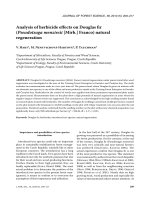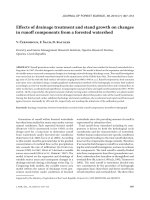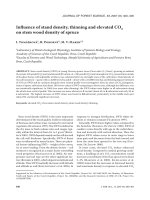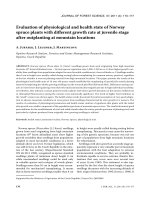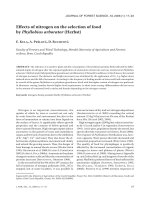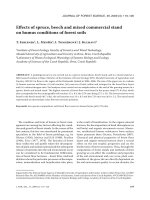Báo cáo lâm nghiệp: "Effects of watering after lifting and exposure before planting on plant quality and performance in Oriental spruce " pptx
Bạn đang xem bản rút gọn của tài liệu. Xem và tải ngay bản đầy đủ của tài liệu tại đây (261.55 KB, 5 trang )
Short
note
Effects
of
watering
after
lifting
and
exposure
before
planting
on
plant
quality
and
performance
in
Oriental
spruce
M Genç
Department
of
Silviculture,
Faculty
of
Forestry,
Karadeniz
Technical
University,
Trabzon
61080,
Turkey
(Received
22
December
1994;
accepted
31
May
1995)
Summary—
Four-year-old
transplants
of
Oriental
spruce
(Picea
orientalis
(L)
Link)
were
lifted
on
28
March
1990,
30
March
1990
and
2
April
1990
during
the
postdormancy
phase.
Some
of
them
were
then
watered
immediately,
and
all
of
the
seedlings,
watered
and
unwatered,
were
kept
in
moist
conditions
within
cloth
sacks.
A
part
of
the
watered
transplants
were
planted
immediately,
whereas
the
others
were
planted
after
60
min
exposure.
However,
the
unwatered
transplants
were
subjected
to
drought
on
the
ground
for
0,
15,
30
and
60
min.
Plants
with
60
min
exposure
were
watered
before
planting
only.
After
treatments,
shoot
water
potentials
were
measured
using
the
pressure
chamber
technique.
Best
water
potential,
survival
and
growth
were
obtained
from
transplants
watered
after
lifting.
In
these
seedlings,
exposure
particularly
stimulated
root
growth.
With
unwatered
transplants,
however,
both
water
poten-
tial
and
relative
increment
of
height
or
dry
weight
declined
significantly
as
exposure
time
prolonged,
but
survival
and
rate
of
terminal
shoots
reduced
only
slightly.
Picea
orientalis
/ watering
/
exposure
/
shoot
water
potential
/ seedling
performance
Résumé —
Effets
de
mouillage
et
de
l’exposition
à
l’air
avant
transplantation,
sur
la
qualité
et
les
performances
de
plants
d’épicéa
oriental.
Les
plants
d’épicéa
oriental repiqués
à
4
ans
sont arra-
chés
pendant
la
période
post-dormance
et
mouillés
ou
non
immédiatement,
puis
protégés
dans
des
sacs
humides.
Une
partie
des
plants
mouillés
sont
plantés
dans
l’état
où
ils
se
trouvent,
les
autres
sont
d’abord
laissés
à
l’air
libre
pendant
60
minutes
puis
sont
plantés.
D’autre
part,
les
plants
non
mouillés
sont
laissés
à
l’air
libre
pendant
0,
15
et
30
minutes
ou
bien
sont
exposés
à
l’air
libre
60
minutes
et
mouillés
avant
plantation.
Les
potentiels
hydriques
des
pousses
sont
mesurés
après
les
traitements
par
la
technique
de
la
chambre
de
pression.
La
survie
et
la
croissance
des
plants
sont
mesurées
à
la
fin
de
la
saison
de
croissance.
Le
potentiel
est
hydrique,
la
survie
et
la
croissance
sont
meilleures
pour
les
plantes
mouillées
avant
transplantation.
Chez
ces
plants
l’exposition
à
l’air
a
stimulé
la
crois-
sance
des
racines.
Cependant,
chez
les
plants
non
mouillés,
potentiel
hydrique
et
croissance
relative
ou
poids
sec
des
plants
ont
diminué
significativement
en
fonction
du
temps
d’exposition
à
l’air,
mais
la
survie
et
la
proportion
des
pousses
terminales
ont
diminué
légèrement.
Picea
orientalis
/ exposition
à
l’air / stress
hydrique / performance
des
plants
INTRODUCTION
Rough
handling
or
root
and/or
shoot
expo-
sure
to
ambient
conditions
before
planting
are
very
important
for
seedling
performance,
because
these
treatments
directly
affect
water
relations
and
root
growth
capacity
of
stocks
and
increase
mortality.
Sharpe
et al
(1990)
found
in
the
2-year-old
undercut
or
transplanted
stocks
of
Sitka
spruce
and
Douglas
fir
that
rough
handling
lowered
root
growth
capacity
as
well
as
survival.
Bal-
neaves
(1987)
determined
in
macrocarpa
(Cupresus
macrocarpa)
and
radiata
pine
that
water
potential
in
both
species
declined
with
increased
periods
of
root
exposure.
The
same
results
were
also
given
by
Coutts
(1981)
for
Sitka
spruce.
In
another
study,
Menzies
(1981)
emphasized
that
water
dip-
ping
radiata
pine
seedlings
after
exposure
and
just
before
planting
decreased
mortal-
ity.
In
radiata
pine
seedlings,
therefore,
water
dipping
after
lifting
and
again
before
planting
is
recommended.
These
investigations
are
necessary
to
ensure
successful
outplanting.
However,
such
a
study
has
not
yet
been
realized
in
Picea
orientalis.
This
short
note
describes
how
watering
after
lifting
and
exposure
before
planting
affect
the
water
potential,
growth
and
survival
of
Oriental
spruce
trans-
plants.
Experimental
treatments
The
study
was
conducted
at
"Of
Forest
Nursery"
located
40°59’03"N,
40°20’19"E
in
northeast
Anatolia.
Study
areas
were
about
5
m
above
sea
level
and
located
on
acidic
soils
(pH
=
5.3)
with
sandy
loam
texture.
Trials
were
set
up
with
4-year-old
trans-
plants
of
Picea
orientalis
from
the
prove-
nance
of
Cataldere-Maden
as
three
repli-
cations
in
a
randomized
block
design;
that
is,
there
were
360
plants
per
treatment
(120
plants
per
block).
The
experiments
were
established
during
3
days.
Thus,
the
first
transplants
were
randomly
lifted
on
28
March
1990,
and
utilized
in
Treatments
IV
and
VI.
Likewise,
50
samples
from
the
trans-
plants
were
randomly
picked
out
to
mea-
sure
the
major
morphological
properties
of
stocks.
Treatments
I and
II
were
established
with
stocks
lifted
on
30
March
1990.
The
transplants
to
be
used
in
Treatments
III
and
V
were
lifted
on
2
April
1990.
After
lifting,
a
part
of
the
transplants
were
immediately
moisturized
using
a
watering
can,
and
all
were
then
kept
together
in
moist
conditions
in
cloth
sacks,
after
pruning
the
roots
to
a
20
cm
length.
A
part
of
the
watered
transplants
were
promptly
planted
(Treatment I),
whereas
the
others
were
first
placed
on
the
ground
for
air
drying
for
60
min,
and
then
planted
(Treatment II).
The
unwatered
transplants,
however,
were
subjected
to
drought
on
the
ground
for
0, 15,
30
and
60
min
(Treatments
III,
IV
and
V,
respectively).
A
part
of
the
unwatered
transplants
treated
for
60
min-
utes
were
also
moisturized
using
a
watering
can
just
before
planting
(Treatment
VI).
The
exposure
was
conducted
between
11:30
and
14:30
in
favorable
conditions,
under
partially
cloudy
skies
with
no
wind.
Air
tem-
perature
and
relative
humidity
on
the
ground
were
measured
during
exposure,
and
shoot
water
potentials
were
measured
at
the
5
shoot
samples
from
each
treatment
by
the
use
of
the
pressure
chamber
technique
(table
I).
The
treated
seedlings
were
planted
in
the
nursery
at
about
15
x
20
cm
spacing
into
25
cm
deep
planting
holes.
Plant
performance
parameters
At
the
end
of
the
first
growing
season
after
planting,
the
rates
of
survival
and
terminal
shoots
were
first
defined,
and
major
param-
eters
of
plant
performance
were
measured
on
90
plants
from
each
treatment
(table
II).
Relative
increments
of
the
height
and
dry
weight
of
transplants
were
then
calculated.
Proportional
data
were
transformed
to
carry
out
ANOVA
using
the
Arcsin
(P)1/2
method.
Relative
increment
data
were
also
trans-
formed,
multiplying
with
the
mean
values
determined
on
4-year-old
transplants
(Kalip-
siz,
1981).
Statistical
analysis
was
carried
out
on
the
data
using
the
randomized
blocks
ANOVA
and
Duncan’s
multiple
range
test
at
the
probability
level
of
≤
0.05
(table
II).
RESULTS
AND
DISCUSSION
Average
shoot
water
potential
measured
after
Treatments
ranged
from
-0.53
to
-3.07
M Pa.
There
were
no
marked
differences
between
Treatments
I,
II
and
III,
but
differences
between
the
others
were
statistically
signifi-
cant
at
the
least
P
≤ 0.05
confidence
level.
The
same
results
were
determined
for
the
growth
parameters
of
transplants,
except
for
survival
and
the
rate
of
terminal
shoot
occur-
rence.
Best
water
potential
(-0.53
and
-0.75
MPa),
survival
(99
and
1.00%)
and
growth
were
obtained
from
transplants
watered
after
lifting.
In
these
seedlings,
exposure
to
ambi-
ent
conditions
particularly
stimulated
root
growth.
Transplants
in
Treatment
II gave
a
higher
root
increment
(1.15%)
than
saplings
in
all
the
remaining
treatments
(table
II).
With
unwatered
transplants,
however,
shoot
water
potential
(Ψ
w)
decreased,
depending
on
high
temperature
and
on
low
relative
humidity
during
air
drying.
Thus,
Ψ
w
in
Treatment
IV
was
lower
than
in
Treat-
ments
V
or
VI
(table
I).
Hence,
both
the
sur-
vival
and
relative
increment
of
height
or
dry
weight
declined
significantly,
as
Ψ
w
dimin-
ished,
but the
rate
of
terminal
shoot
decreased
only
slightly
(table
II).
Results
from
this
study
indicate
that
per-
formance
of
the
Picea
orientalis
transplants
watered
after
lifting
differed
markedly
from
unwatered
saplings
of
the
same
species,
and
with
watered
transplants
air
drying
before
planting
for
60
min
stimulate
root
growth.
When
considering
the
results
of
some
similar
studies,
this
is
not
a
surpris-
ing
result.
Thus,
Cleary
and
Zaerr
(1980)
suggest
that
the
bare-root
seedlings
of
the
Douglas
fir
and
the
ponderosa
pine
should
have
a
water
potential
of
greater
than
-0.5
MPa
in
order
to
avoid
low
survival
and
poor
growth.
The
same
results
have
also
been
established
for
radiata
pine
stocks
(Rook
and
Menzies,
1981).
Likewise,
for
the
Sitka
spruce
transplants,
Coutts
(1981)
empha-
sizes
that
"Exposure
of
the
root
caused
a
faster
decrease
in
fine
root
moisture
con-
tent
than
exposure
of
the
shoot".
In
loblolly
pine
as
well,
survival,
height
and
root
growth
potential
significantly
decreased
as
expo-
sure
time
before
planting
was
extended
(Feret
et
al,
1985).
Balneaves
(1987)
reported,
however,
that
root
growth
capac-
ity
of
macrocarpa
seedlings
was
not
affected
by
the
length
of
root
exposure.
In
the
present
study,
transplants
were
not
washed
after
lifting
or
before
drying
treat-
ments;
that
is,
transplants
had
soil
or
soil
particles
around
their
root
systems,
so
that
fine
roots
probably
did
not
suffer
large-scale
damage
during
exposure.
Thus,
shoot
water
potential
in
Treatment
II was
reduced
to
only
-0.75
MPa
since
watering
after
lifting
had
increased
shoot
and
root
water
potentials
and
prevented
water
losses
during
handling.
Note
that
the
shoot
water
potential
level
is
in
agreement
with
ideal
water
stress
not
hav-
ing
a
limiting
factor
for
physiological
pro-
cesses
(Cleary
and
Zaerr,
1984).
In
conclusion,
water
stress
which
does
not
limit
the
physiological
processes
and
does
not
destroy
the
fine
roots
on
a
large-
scale
has
probably
particularly
stimulated
the
root
growth.
The
planting
success
of
the
transplants
in
Treatment
II should
not
be
rejected,
considering
that
if
the
water
poten-
tial
is
sufficient,
fine
roots
would
not
suffer
significant
damage
by
drying
treatment
under
the
auspices
of
soil
around
the
root
system.
Even
root
growth
may
be
promoted
by
subjecting
them
to
drought,
or
short-term
exposure
may
not
affect
the
root
growth
of
Oriental
spruce
stocks
as
determined
in
macrocarpa
seedlings
(Balneaves,
1987).
Hence,
new
studies
must
be
conducted
in
the
Oriental
spruce.
REFERENCES
Balneaves
JM
(1987)
Root
growth
capacity
of
Cupre-
sus
macrocarpa
and
Pinus
radiata
seedlings.
NZ
Forestry
8
Cleary
BD,
Zaerr
JB
(1980)
Pressure
chamber
tech-
niques
for
monitoring
and
evaluating
seedling
water
status.
NZ J For Sci 10,
133-141
Cleary
BD,
Zaerr
JB
(1984)
Guidelines
for
measuring
plant
moisture
stress
with
a
pressure
chamber.
PMS
Instrument
Co,
Corvallis,
OR,
USA
Coutts
MP
(1981)
Effects
of
root
or
shoot
exposure
before
planting
on
the
water
relations,
growth,
and
survival
of
Sitka
spruce.
Can
J
For
Res
11, 703-709
Feret
PP,
Kreh
RE,
Mulligan
C
(1985)
Effects
of
air
drying
on
survival,
height,
and
root
growth
potential
of
loblolly
pine
seedlings.
South
JAppl
For 9,
125-
128
Kalipsiz
A
(1981)
Statistical
methods
[In
Turkish].
Pub-
lication
of
Forest
Faculty
of
Istanbul
University,
Issue
no
2837/294,
558,
Istanbul,
Turkey
Menzies
MI
(1981)
Puddling
and
water
dipping
of
root
system —
a
review.
In:
Forest
nursery
and
establish-
ment practice
in
New Zealand.
FRI
Symposium
no
22,
Part
1,
Nursery
Practice,
March
23-27, 1981
(CGR
Chavasse,
ed),
New
Zealand
Forest
Service,
153-
159
Rook
DA,
Menzies
MI
(1981)
Methods
of
determining
physiological
quality
of
planting
stock.
In:
Forest
nursery
and
establishment
practice
in
New Zealand,
FRI
Symposium
no
22,
Part
1,
Nursery
Practice,
March
23-27,
1981
(CGR
Chavasse,
ed),
New
Zealand
Forest
Service,
159-169
Sharpe
AL,
Mason
WL,
Howes REJ
(1990)
Early
forest
performance
of
roughly
handled
Sitka
spruce
and
Douglas
fir
of
different
plant
types.
Scott
For 44,
257-
265
